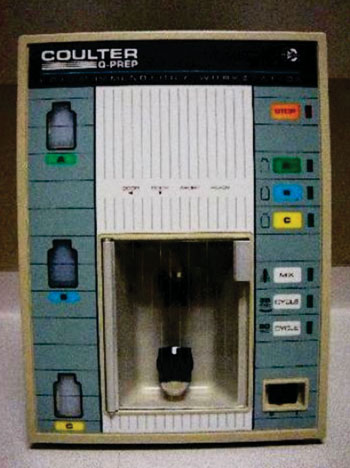Surface Marker Allows New Diagnostic Approaches for Sarcoidosis
By LabMedica International staff writers
Posted on 09 Nov 2015
A new strategy has been developed to determine monocyte subsets involved in diseases that could help facilitate the diagnosis of sarcoidosis and may improve respective patient management.Posted on 09 Nov 2015
Monocytes are white blood cells that are crucial to human immune defense and are precursor cells of macrophages and dendritic cells that circulate in the blood until they invade their respective target tissue where they defend the body against exogenous structures.

Image: The Q-Prep/ImmunoPrep lysing system workstation (Photo courtesy of Beckman Coulter).
Scientists at Helmholtz-Zentrum (Munich, Germany) and their colleagues analyzed blood samples of patients suffering from sarcoidosis. This disease, which often leads to damage of the patients' lungs, is caused by a strong immune reaction and a concomitant formation of nodules in the tissue. The underlying mechanisms are still unclear but scientists are convinced that monocytes play a critical role.
The investigators mixed blood with directly conjugated monoclonal antibodies for 20 minutes on ice in the dark. Samples were lysed in a Q-prep workstation (Beckman Coulter, Brea CA, USA) including 0.1% formaldehyde fixation. Equal volumes of counting beads were added and samples were run on a FACSCalibur (Becton-Dickinson; Franklin Lakes, NJ, USA) for 4-color-analysis. A total of 5,000 classical monocytes were acquired per sample.
The team showed that the cell surface marker 6-sulfo LacNAc (slan) can define slan-positive CD14+CD16++ non-classical monocytes and slan-negative CD14++CD16+ intermediate monocytes. Gene expression profiling confirms that slan-negative intermediate monocytes show highest expression levels of major histocompatibility complex (MHC) class II genes, while a differential ubiquitin signature is a novel feature of the slan approach. Using the slan approach they showed that slan-negative intermediate monocytes are increased in sarcoidosis and slan-positive non-classical monocytes are depleted in hereditary diffuse leukoencephalopathy with spheroids (HDLS). The study was published on October 6, 2015, in the journal Blood.
Related Links:
Helmholtz-Zentrum
Beckman Coulter
Becton-Dickinson














